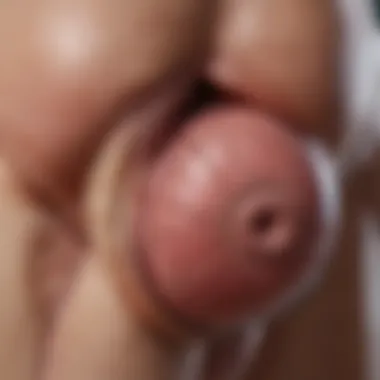Understanding Testicular Pain: Causes and Solutions


Intro
Testicular pain is a complex issue that can affect various individuals, often leading to discomfort and concern. The testicles are sensitive organs, and pain in this region can arise from numerous underlying causes. This article seeks to unravel the nature of testicular pain, offering insights that not only address symptoms but also highlight necessary medical evaluations. It is essential to recognize that while some causes might be benign, others could potentially indicate serious health concerns.
Understanding testicular pain involves more than acknowledging its presence. It requires a nuanced approach to discern the various indications and implications of discomfort in this sensitive area. Knowledge about potential causes, treatment options, and when to seek medical assistance can empower individuals to take proactive steps toward their health.
Key Takeaways
- Main Causes: Testicular pain may stem from conditions such as epididymitis, testicular torsion, hernias, or trauma. Each cause has distinct characteristics and implications.
- Symptoms to Watch: Associated symptoms may include swelling, redness, or changes in the size of the testicles.
- Importance of Diagnosis: Accurate diagnosis and timely treatment are crucial in managing testicular pain effectively.
- Potential Treatments: Options vary based on the diagnosis but may include medications, physical therapy, or surgical interventions.
In-Depth Analysis
Understanding the Causes
Testicular pain can emerge from various sources, each bringing unique challenges. Among frequent causes are:
- Epididymitis: Inflammation of the epididymis, often due to infection. Symptoms include swelling and tenderness.
- Testicular Torsion: A medical emergency where the spermatic cord becomes twisted. It requires immediate surgical intervention to prevent damage.
- Hernias: Inguinal hernias may lead to pain if tissue protrudes through a weak spot.
- Trauma: Injuries from sports or accidents can also contribute significantly to pain.
Each of these conditions involves distinct mechanisms, diagnosis pathways, and implications for treatment.
Symptoms and Implications
Knowing the symptoms associated with testicular pain is critical. These can range from varying degrees of pain intensity to additional physical indicators.
- Pain Characteristics: Sometimes sharp, other times dull or throbbing.
- Swelling and Redness: Inflammation may accompany pain in conditions like epididymitis.
- Changes in Size: One testicle may appear larger than the other, a sign that should not be ignored.
Testicular pain warrants immediate attention, especially if accompanied by severe swelling or signs of infection.
Treatment and Solutions
Approach to treatment is contingent on the underlying diagnosis. Some common strategies include:
- Antibiotics: For infections like epididymitis.
- Pain Relief: Over-the-counter medications can help manage symptoms.
- Surgery: In severe cases, such as testicular torsion, surgical procedures may be necessary.
Understanding these solutions enables individuals to engage in informed discussions with health professionals, ensuring they take appropriate actions.
Epilogue
Testicular pain is undeniably a significant concern, necessitating careful evaluation and understanding. By grasping the potential causes and recognizing symptoms, individuals are better positioned to seek the necessary medical evaluation. This guide serves as a foundational resource, promoting awareness and empowering informed decision-making for long-term health.
Defining Testicular Pain
Testicular pain is a significant health concern that warrants thorough exploration. Understanding this condition is essential because it can be an indicator of various underlying health issues. Early identification of the nature and cause of testicular pain can prevent serious complications and enhance treatment outcomes.
What is Testicular Pain?
Testicular pain refers to discomfort experienced in one or both testicles. This pain can range from mild to severe and may arise suddenly or develop gradually. In some instances, the discomfort may radiate to other areas such as the groin or abdomen. It can arise due to numerous factors, including injuries, infections, or more serious conditions. Being aware of the specifics can aid in deciding the right path for evaluation and treatment.
Common Symptoms
Symptoms associated with testicular pain can vary widely. They may include:
- Sharp or dull pain in one or both testicles.
- Swelling in the affected area.
- Redness or warmth around the testis.
- Pain during urination or ejaculation.
- Nausea or vomiting, which may accompany severe pain.
Recognizing these symptoms is crucial. Appropriate awareness can lead to prompt medical advice and intervention. Testicular pain should not be dismissed, as it may signal a serious concern.
Important Note: If testicular pain is accompanied by swelling or changes in color, seeking medical attention promptly is advised.
Potential Causes of Testicular Pain


Understanding the different potential causes of testicular pain is crucial. It allows individuals to identify symptoms that may require medical attention. Knowing the various origins of pain can inform effective management and treatment strategies. As several complex conditions can lead to discomfort, recognizing each cause enables targeted interventions and improves health outcomes.
Infections
Infections represent a significant category of causes for testicular pain. They can disrupt daily life and lead to serious complications if not addressed promptly.
Epididymitis
Epididymitis occurs when the epididymis, a tube that stores and carries sperm, becomes inflamed. This condition often results from a bacterial infection, commonly associated with sexually transmitted infections like Chlamydia or Gonorrhea.
The key characteristic of epididymitis is pain that typically starts gradually and may worsen over hours or days. This condition becomes a beneficial focus in this article due to its high prevalence among sexually active males.
A unique feature of epididymitis is its manageable nature when treated early. Antibiotics usually prove effective. However, failing to seek treatment can lead to complications such as infertility or chronic pain.
Orchitis
Orchitis refers to the inflammation of one or both testicles, often resulting from viral infections such as mumps but can also be bacterial. The key characteristic here is the swelling of the testicle, which may be accompanied by severe pain and tenderness.
Orchitis is a significant inclusion in the discussion, as it can share symptoms with epididymitis but requires different treatment approaches. The unique feature of orchitis is its potential to cause long-term complications, like testicular atrophy, if not addressed timely. Awareness of this condition is crucial in understanding the broader implications of testicular pain.
Trauma and Injury
Injuries to the testicular area can occur due to sports, accidents, or other physical activities. Such instances often lead to acute and intense pain and may require immediate medical attention. It is essential to recognize these incidents, as timely intervention can reduce the risk of long-term damage and preserve reproductive health.
Testicular Torsion
Testicular torsion is a surgical emergency, characterized by the twisting of the spermatic cord, cutting off blood supply to the testicle. Quick identification and intervention are crucial; otherwise, it can lead to irreversible damage. Symptoms include sudden severe pain and swelling in the affected testicle. Awareness of testicular torsion is vital, as the rapid response can save a testicle, making it a critical topic in the discussion of testicular pain.
Hernias
A hernia occurs when tissue protrudes through a weak spot in the abdominal muscles. Inguinal hernias can lead to pain in the testicular region. Symptoms generally include discomfort that may worsen with activity or straining. Understanding hernias is beneficial for recognizing conditions that can mimic testicular pain.
Varicocele
Varicocele refers to enlarged veins within the scrotum, similar to varicose veins experienced in the legs. Often asymptomatic, varicoceles can sometimes cause discomfort or pain. They can impact fertility as well. Recognizing this condition is important, as it may necessitate treatment if associated with pain or fertility issues.
Tumors
Testicular tumors can be benign or malignant. Though less common, they require serious attention. Symptoms may include noticeable lumps or changes in size. Early detection is crucial for effective treatment and improved prognosis. The awareness of testicular tumors helps highlight the significance of regular self-examinations and seeking medical guidance when changes are noticed.
Recognizing Testicular Pain Severity
Recognizing testicular pain severity is crucial for effective management and intervention. It can sometimes indicate underlying conditions that may require immediate medical attention. Understanding how to interpret the pain's intensity and associated symptoms can influence the outcome significantly. Being aware of various pain characteristics can also assist healthcare professionals in diagnosing the condition appropriately. This section will examine when it is necessary to seek medical help and self-evaluation techniques that individuals can use.
When to Seek Medical Attention
Testicular pain can arise from numerous causes, some of which may pose serious health risks. Recognizing the points at which one should seek medical attention can be lifesaving. Consider the following symptoms:
- Sudden, severe pain: If pain appears suddenly and is intense, it may indicate a serious condition such as testicular torsion.
- Swelling or lumps: Noticeable swelling or any lumps around the testicle can signal infections or tumors.
- Changes in skin color: If the scrotum color changes to a darker shade or appears bruised, it could require immediate evaluation.
- Fever or chills: Accompanying fever may suggest an infection, necessitating prompt treatment.
- Nausea or vomiting: These could sometimes relate to an abdominal issue affecting the testicles.
Determining when to seek help can feel overwhelming. If doubt arises, it is generally best to consult a medical professional. Prompt attention might prevent complications and can better your prognosis.
Self-Evaluation Techniques
Self-evaluation offers a proactive approach for individuals experiencing testicular discomfort. Regular self-examinations help to detect changes or issues early. Consider these steps for effective self-assessment:
- Perform a gentle examination: While standing in front of a mirror, gently palpate the area with both hands. Look for abnormalities like lumps, hardness, or swelling.
- Check for tenderness: While assessing, note any regions that are particularly sensitive. It is important to assess pain level without forcing pressure.
- Monitor changes: Keep a record of any changes in size or texture. This information can be valuable for medical appointments.
- Assess habits: Think about recent activities that may have caused trauma or injury, as these details could be relevant for your healthcare provider.
By familiarizing oneself with normal anatomy and sensations, recognizing abnormalities becomes easier. This proactive approach is vital for early detection and appropriate medical advice. The importance of prompt evaluation cannot be overstated, as it significantly impacts outcomes.


Diagnosis of Testicular Pain
Diagnosing testicular pain is crucial for effective treatment and health management. Testicular pain can stem from various causes, and identifying the root is essential for choosing the right intervention. Early diagnosis can lead to better outcomes and help prevent complications. It allows healthcare professionals to make informed decisions regarding possible treatment options.
Accurate diagnosis also alleviates patient anxiety by providing clarity on the situation. Ensuring that the diagnosis process includes a comprehensive approach can lead to better insights and tailored treatment plans.
Medical History and Examination
The first step in diagnosing testicular pain is obtaining a detailed medical history. A healthcare provider asks about the onset, duration, and intensity of pain. Understanding any preceding events or trauma involves crucial details. Patients should share any other symptoms accompanying the pain, such as swelling or fever. This information assists in narrowing down potential causes.
A physical examination is the next component. The healthcare provider examines the testicles for tenderness, swelling, or any abnormalities. This examination helps provide context around the reported pain. The combination of medical history and physical examination serves as a foundation for further diagnostic testing.
Diagnostic Tests
Ultrasound
Ultrasound plays a vital role in diagnosing testicular pain. This imaging technique utilizes sound waves to create detailed images of the testicular region. The key characteristic of ultrasound is its non-invasive nature, making it a preferred choice for first-line investigation.
One unique feature of ultrasound is its ability to differentiate between solid and cystic lesions. This distinction is crucial for diagnosing conditions such as tumors or cysts. The main advantage of ultrasound is that it can be performed quickly, providing immediate results. However, one disadvantage may include the need for subsequent imaging if findings are inconclusive.
Blood Tests
Blood tests are another important tool in diagnosing testicular pain. They can help detect signs of infection or other underlying conditions. One key characteristic of blood tests is their ability to reveal elevated levels of specific markers. These markers are associated with conditions such as infections or tumors.
A unique feature of blood tests is their usability in monitoring treatment progress. This characteristic can help determine if the current treatment is effective. While blood tests are generally safe, they can require additional testing if results indicate issues.
Urinalysis
Urinalysis is a common diagnostic procedure that assists in identifying urinary tract infections or signs of other conditions affecting the testicular region. Its key characteristic lies in its accessibility; it can be performed in many healthcare settings and provides quick results.
One unique aspect of urinalysis is that it can reveal the presence of red blood cells, white blood cells, and bacteria. These indicators are essential for diagnosing infections or other disorders. However, urinalysis may sometimes provide false-positive results, necessitating further diagnostic work.
Emphasizing a detailed diagnostic approach helps ensure that treatment is accurately aligned with the underlying issue.
Treatment Options for Testicular Pain
Addressing testicular pain is vital for effective management and improving quality of life. The options range from medications to surgical interventions. Choosing the right approach often depends on the underlying cause. Understanding the treatment landscape helps individuals make informed decisions and find relief from discomfort.
Medications
Medications play an essential role in alleviating testicular pain. They can address both acute and chronic discomfort, depending on the underlying issues. Two primary categories are pain relievers and antibiotics.
Pain Relievers
Pain relievers, like ibuprofen and acetaminophen, are common choices for managing testicular pain. These medications target inflammation and reduce discomfort, offering quick relief in many cases. They are especially beneficial for pain resulting from mild injuries or minor infections.
The key characteristic of pain relievers is their ease of access. Many are available over the counter, making them popular for immediate response. However, users should be aware of their limitations. Pain relievers only manage symptoms but do not address the root cause of pain.
Unique to pain relievers is their ability to be combined with other treatments. This could enhance their effectiveness. Yet, relying solely on pain management strategies can be shortsighted. Individuals should be aware of potential side effects, such as gastrointestinal discomfort, associated with long-term use.
Antibiotics
Antibiotics are critical when infections cause testicular pain. In cases like epididymitis or orchitis, antibiotic therapy is essential for eliminating pathogens. Here, the key characteristic is their ability to target specific bacterial infections effectively.
In this article, antibiotics represent a beneficial choice for individuals with diagnosed bacterial infections as they can significantly reduce both infection and associated pain. A unique feature of antibiotics is that they address the underlying problem rather than just mask symptoms.
However, it is crucial to understand the careful administration of antibiotics. Not all testicular pain is due to infections, and inappropriate use can lead to resistance problems. Potential disadvantages include side effects like nausea and the need for strict adherence to prescribed regimens for effectiveness.
Surgical Interventions


In certain cases, when conservative treatments fail, surgical interventions might be necessary. For conditions such as testicular torsion or hernias, timely surgical procedures can prevent severe complications. Surgical options may provide a means to resolve the issue definitively and restore function. The implications of not pursuing surgical care can be detrimental, leading to chronic pain or potential loss of function.
Physical Therapy
Physical therapy can also be beneficial for those who experience pain due to muscular or mobility issues. A physical therapist can guide patients through tailored exercises that improve strength while reducing discomfort. This approach can be an effective complement to pharmacological treatments, focusing on long-term relief and improved quality of life.
Care and Prevention
Understanding the importance of care and prevention for testicular pain can significantly impact long-term health and well-being. By implementing proper practices, individuals can reduce the risk of developing conditions or experiencing painful episodes in the future. This part of the article will explore specific elements essential for promoting testicular health.
Proper Hygiene Practices
Maintaining proper hygiene is crucial for preventing infections that may lead to testicular pain. Regular bathing and washing of the genital area with mild soap can help eliminate bacteria. Particular attention should be paid to the folds of skin, as moisture can accumulate there and promote bacterial growth. It is advisable for men to wear breathable, cotton underwear to reduce moisture and prevent irritation.
Avoiding the use of strongly scented soaps or body washes is also recommended. These products can cause allergic reactions, leading to discomfort or inflammation. Furthermore, regular washing of sports and gym clothing helps minimize exposure to pathogens, which is particularly important for those who often engage in physical activities.
Protective Gear for Sports
Involvement in sports can elevate the risk of testicular injuries, which can lead to pain and complications. Wearing protective gear, such as athletic cups, is an effective method to safeguard against trauma during contact sports. This type of equipment is designed to absorb impacts and prevent injury, which is especially vital in sports like football or hockey.
It’s equally important to use the right gear when participating in recreational activities. For activities like biking, padded shorts can provide an extra layer of protection. Awareness of one’s surroundings and playing safely also contribute significantly to avoiding injuries that may result in pain.
Regular Self-Examinations
Self-examinations are a proactive measure individuals can take to monitor their testicular health. Performing monthly self-checks helps familiarize oneself with the normal size and shape of the testicles, making it easier to detect any unusual changes.
During an exam, one should gently feel each testis with the fingers, looking for lumps, swelling, or discomfort. If any abnormalities are noticed, prompt consultation with a healthcare provider is essential. Detecting issues early can lead to more effective treatment and reduce the chances of long-term complications.
Regular self-examinations can contribute to early detection of potential issues, which is pivotal in managing overall testicular health.
In summary, care and prevention are vital components in addressing and managing testicular pain. Emphasizing hygiene, protective measures, and self-awareness builds a foundation for better health outcomes.
Living with Testicular Pain
Living with testicular pain presents unique challenges for many individuals. This section discusses how to cope with discomfort and improve overall quality of life. The key is understanding the pain and recognizing its impact on daily activities. By addressing both physical and emotional aspects, one can achieve better management strategies.
Managing Chronic Pain
Chronic testicular pain can be debilitating. It often requires a multi-faceted approach for effective management. Here are some strategies worth considering:
- Medication: Over-the-counter pain relievers, like ibuprofen or acetaminophen, can be effective. If pain persists, a healthcare provider may prescribe stronger medications.
- Physical Therapy: Engaging in physical therapy can help alleviate pain. A trained therapist can introduce exercises specific to the pelvic region.
- Alternative Treatments: Some individuals find relief through acupuncture or chiropractic care. While evidence may vary, these options are worth discussing with a healthcare provider.
It's crucial to tailor pain management strategies to individual needs. They should consistently be evaluated to determine effectiveness.
Psychological Impact of Testicular Pain
Testicular pain can profoundly affect mental well-being. Chronic pain often leads to anxiety and depression, which may complicate one’s condition. It is essential to address these emotional factors:
- Emotional Support: Talking with friends, family or even professionals can provide relief. Opening up about the experience helps in processing feelings.
- Mindfulness and Relaxation Techniques: Practices like meditation and deep-breathing exercises can ease anxiety. These methods promote relaxation and help in coping with stress.
- Education: Understanding the condition can lessen fear and uncertainty. Knowledge empowers patients in their self-management efforts.
"When individuals grasp both the physical and emotional aspects of their pain, they often experience improved outcomes."
Ultimately, living with testicular pain requires a consideration of both physical symptoms and psychological well-being. This holistic approach enables patients to navigate their experience more effectively. By managing chronic pain and understanding its psychological implications, individuals can enhance their quality of life.
Epilogue
In closing, the discussion around testicular pain is critical for both understanding and addressing this often sensitive issue. The various causes and implications of testicular pain all point towards the need for vigilant awareness and appropriate action when discomfort arises. This article provides a comprehensive overview, guiding readers through the complexities of identifying symptoms, potential origins of pain, and available treatment options.
Recap of Key Points
- Definition: Testicular pain can arise from numerous sources, ranging from infections to trauma and even tumors. Recognizing the type of pain and any accompanying symptoms is vital for effective diagnosis and treatment.
- Causes and Assessment: It’s important to distinguish between urgent cases, such as testicular torsion, and less critical situations. Factors like previous injuries, recent infections, and any noticeable changes in the area should be noted.
- Diagnosis and Treatment: A thorough medical evaluation, which may include diagnostic tests like ultrasounds and blood tests, is necessary. Treatment options range from medications to surgical interventions, depending on the underlying cause.
- Living with Pain: Chronic testicular pain has a significant psychological impact, necessitating comprehensive pain management strategies that address both the physical and emotional aspects of chronic conditions.
Importance of Professional Guidance
Seeking professional guidance is paramount when dealing with testicular pain. The nuances of this condition mean that self-diagnosis is often inadequate. Health professionals, including urologists, offer not just treatment, but also critical insights into preventive care and lifestyle adjustments. They can provide a structured plan tailored to individual needs, ensuring both immediate relief and long-term management of any underlying issues. Consulting a professional can lead to better outcomes and peace of mind.
"The impact of testicular discomfort reaches far beyond the physical. Effective management requires a holistic approach, integrating medical advice with lifestyle considerations."







